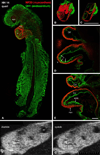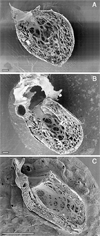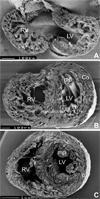Embryogenesis of the heart muscle
- PMID: 18598977
- PMCID: PMC2715960
- DOI: 10.1016/j.hfc.2008.02.007
Embryogenesis of the heart muscle
Abstract
This article concerns the development of myocardial architecture--crucial for contractile performance of the heart and its conduction system, essential for generation and coordinated spread of electrical activity. Topics discussed include molecular determination of cardiac phenotype (contractile and conducting), remodeling of ventricular wall architecture and its blood supply, and relation of trabecular compaction to noncompaction cardiomyopathy. Illustrated are the structure and function of the tubular heart, time course of trabecular compaction, and development of multilayered spiral systems of the compact layer.
Figures



References
-
- Anderson RH, Ho SY. The architecture of the sinus node, the atrioventricular conduction axis, and the internodal atrial myocardium. J Cardiovasc Electrophysiol. 1998;9:1233. - PubMed
-
- Ben-Shachar G, Arcilla RA, Lucas RV, et al. Ventricular trabeculations in the chick embryo heart and their contribution to ventricular and muscular septal development. Circ Res. 1985;57:759. - PubMed
-
- Blausen BE, Johannes RS, Hutchins GM. Computer-based reconstructions of the cardiac ventricles of human embryos. Am J Cardiovasc Pathol. 1990;3:37. - PubMed
-
- Butcher JT, McQuinn TC, Sedmera D, et al. Transitions in early embryonic atrioventricular valvular function correspond with changes in cushion biomechanics that are predictable by tissue composition. Circ Res. 2007;100:1503. - PubMed
-
- Challice CE, Viragh S. The embryonic development of the mammalian heart. In: Challice CE, Viragh S, editors. Ultrastructure of the mammalian heart. New York: Academic Press; 1973. p. 91.
Publication types
MeSH terms
Grants and funding
LinkOut - more resources
Full Text Sources

